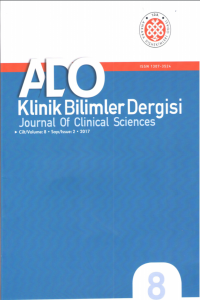Termoplastik Rezinler
Termoplastik Rezinler, Asetal rezin, Termoplastik naylon, Termoplastik akrilik
Thermoplastic Resins
___
- Campo EA. Selection of Polymeric Materials. New York: William Andrew Inc., Chapter 1, 2008.
- Kutsch VK, Whitehouse J, Schermerhorn K, Bowers R. The evolution and advancement of dental thermoplas- tics. 2003. Erişim: [http://www.towniecentral.com/ Dentaltown/Article.aspx?aid=387]. Erişim Tarihi: 26.9.2008.
- Ewoldsen N. What are the clinical disadvantages and limitations associated with metal- free partial dentures? 2007. Erişim: [http://www.cda- adc.ca/jcda/vol-73/issue-1/41.pdf]. Erişim Tarihi: 26.10.2008.
- Özkan Y, Arıkan A, Akalın B, Arda T. A study to as- sess the colour stability of acetal resins subjected to thermocycling. Eur J Prosthodont Restor Dent 13:10-14, 2005.
- Kansu G. Bölümlü dişsizliklerde estetik. Türk Dişhek Bir- liği Derg 83;68-72, 2004.
- Arıkan A., Özkan YK., Arda T., Akalın B. An in vitro investigation of water sorption and solubility of two ac- etal denture base materials. Eur J Prosthodont Restor Dent 13:119-122. 2005.
- Wu JC, Latta GH, Wicks RA, Swords RL, Scarbecks M. In vitro deformation of acetyl resin and metal alloy re- movable partial denture direct retainers. J Prosthet Dent 90:586-590, 2003.
- Arda T, Arıkan A. An in vitro comparison of retentive force and deformation of acetal resin and cobalt-chro- mium clasps. J Prosthet Dent 94:267-274, 2005.
- ISSN: 1307-3540
- Yayın Aralığı: Yılda 3 Sayı
- Başlangıç: 2006
- Yayıncı: Ankara Diş Hekimleri Odası
Alper ÖZER, Pınar ALTINCI, Gülşen CAN
Füzyon: Bir Literatür Güncellemesi
Aşınmış Dişlerde Protetik Yaklaşımlar
Gamze MANDALI, Arzu Zeynep Yıldırım BİÇER, Zeynep BULUT, Hasan ÜLGEN
Temporomandibuler Eklem Manyetik Rezonans Görüntülerinde Efüzyonun Değerlendirilmesi
M Ercüment ÖNDER, Hakan H TÜZ, Reha Ş KİŞNİŞCİ, İbrahim Tanzer SANCAK
Direkt Kompozit Rezin Veneerlerle Diastema Kapatılması
Gamze MANDALI, Arzu Zeynep Yıldırım BİÇER, Burhan KONAKÇI
Seçil KARAKOCA NEMLİ, Bilge Turhan BAL, Handan YILMAZ, Cemal AYDIN, Şükran YILMAZ
İmplant Kaybı, Risk Faktörleri ve Yüzeyin İmplant Kaybına Etkisi
İntraoral İmplant Planlamasında Üç Boyutlu Görüntüleme Tekniklerinin Kullanımı
Merve BANKOĞLU, Seçil Karakoca NEMLİ
Seçil KARAKOCA NEMLİ, Duygu BOYNUEĞRİ
Beyaz Nokta Lezyonlarının Teşhis ve Tedavi Yöntemleri
Meltem Derya AKKURT, Günseli Güven POLAT, Ceyhan ALTUN, Feridun BAŞAK
